The Impact of Spiritual and Religious Activities on the Well-being and Academic Achievement of the College students at San Sebastian College Recoletos de Cavite
DOI:
https://doi.org/10.7719/jpair.v60i1.930Keywords:
Education, spirituality,, well-being, academic achievement, college students, quantitative research, PhilippinesAbstract
This study investigates the influence of spiritual and religious activities on the well-being and academic success of college students at San Sebastian College Recoletos de Cavite, aiming to address existing gaps in understanding within diverse cultural and religious contexts like the Philippines. Utilizing a quantitative approach, data from 350 randomly selected students were analyzed, revealing a minimal positive linear correlation between engagement in religious activities and overall well-being, alongside a negligible linear relationship with academic performance. ANOVA findings underscored significant variations in impact across different academic disciplines, emphasizing the need for tailored interventions to support students' holistic development. The results suggest a limited association between engagement in religious activities and student outcomes, prompting further research to explore the roles of spirituality and religious engagement in enhancing student well-being and academic success.
Metrics
Downloads
References
Berhanu, K. Z., & Shiferaw, A. A. (2023). The mediating role of healthy lifestyle behavior in the relationship between religious practice and academic achievement in university students. BMC psychology, 11(1), 416.
Bowman, N. A., & Small, J. L. (2012). Exploring a hidden form of minority status: College students' religious affiliation and well-being. Journal of College Student Development, 53(4), 491-509.
David, R., Singh, S., Ribeiro, N., & Gomes, D. R. (2022). Does spirituality influence happiness and academic performance?. Religions, 13(7), 617.
Downloads
Published
Issue
Section
License
Copyright (c) 2025 Mark Joseph Quirante, Marianne Avila

This work is licensed under a Creative Commons Attribution-NonCommercial 4.0 International License.
Open Access. This article published by JPAIR Multidisciplinary Research is licensed under a Creative Commons Attribution-Noncommercial 4.0 International (CC BY-NC 4.0). You are free to share (copy and redistribute the material in any medium or format) and adapt (remix, transform, and build upon the material). Under the following terms, you must give appropriate credit, provide a link to the license, and indicate if changes were made. You may do so in any reasonable manner, but not in any way that suggests the licensor endorses you or your use. You may not use the material for commercial purposes.

























